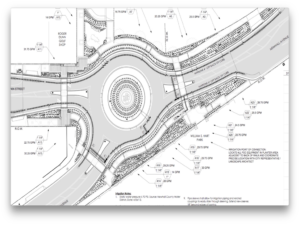Vectorworks has new management and big plans. At their annual Vectorworks Design Showcase user conference, the organization offered a look at their latest accomplishments and talked about plans for the future under the leadership of new CTO Biplab Sarkar.
Vectorworks, being one of the oldest CAD companies in the world, got its start as in 1985 as a resume project by Richard Diehl. He wanted to prove that he could write computer code. Working on the then-new Macintosh, he named the program MiniCAD and his company Graphsoft. Diehl began adding commands specific to the needs of architects and engineers when he realized they were becoming his biggest customers. After Graphisoft of Hungary sued (because they also developed architectural CAD on Macintoshes), he changed the name to Diehl Graphsoft.
By the late 1990s, the software was ported to Windows, and then renamed to Vectorworks. It was later bought by Nemetschek of Germany, a holding company with a dozen independent software firms under its umbrella, such as structural analysis (Scia), modeling and animation (Maxon), and PDF and project management (Bluebeam). Ironically, one of the Nemetschek-owned firms is Graphisoft, former foe of Vectorworks. Nemetschek’s annual revenues are in range of US$350 million, making it about half the size of Bentley Systems.
Vectorworks Becomes BIM
Vectorworks claims an overall user base of just over a half-million. Even though Vectorworks is based in the USA, its two biggest markets are in Japan (40% of revenues) and Germany. The company sells specifically into the architecture, entertainment lighting, rendering, and landscaping verticals.

In recent years, Vectorworks has added BIM (building information modeling), the Parasolid 3D solid modeling kernel, 3D mesh modeling licensed from Pixar, and cloud-based services. This work has been carried out under the direction of chief technology officer Biplab Sarkar; Sarkar figures he has so far implemented in Vectorworks about 75-80% of what Parasolid can do.
The software does more than 2D and 3D CAD; it is popular among its customers for doing technical illustration, which allows them to use the program to generate print and digital presentations for clients. Indeed, the company produces some of its marketing brochures with Vectorworks.
In April a big change happened at the top when former CEO Sean Flaherty was promoted upstairs to chief strategy officer for Nemetschek, while Sarkar became Vectorworks CEO. It’s a big change, because he is only the third CEO in the company’s 31-year history. At a recent user conference, ex-CEO Flaherty joked that he was late for the keynote because there was no name tag waiting for him when he arrived at the convention area, and then had to watch carefully that staff spelled n-e-m-e-t-s-c-h-e-k correctly.
Future of Vectorworks

The annual user conference had the grand name of “Vectorworks Design Summit.” Even though the 600 attendees were pleased with the selection of the new CEO, Sarkar still had to impress the crowd with his plans for the immediate future. No timeline was given, but I would think most of the planned functions will make it into the 2017 release.
Vectorworks Cloud Services was previously available only to customers on subscription, but now parts are available to anyone, such as viewing (via Vectorworks’ Nomad mobile app), online storage (limited to 2GB), and downloading files (from the Vectorworks cloud). Paying customers have access to more tasks online such as updating views and publishing PDFs. Customers also get 20GB of storage.
Vectorworks Graphics Module will display graphics in less time by upgrading all of Vectorworks (including 2D) to OpenGL, and by storing the drawing in the super-fast memory of graphics boards. The result is faster reaction when editing large drawings, and quicker zooming and panning.
Web View/Virtual Reality exports 3D models from Vectorworks for viewing in Web browsers, so that models can be viewed on “any” hardware and operating system. Sarkar showed a virtual reality app for walking through 3D scenes using a smartphone and a Google Cardboard-like attachment.
Resource Manager is being revamped with direct browsing of many parts libraries, searching for parts, and showing parts already used in drawing. This one got a big cheer from the audience.
Vectorworks Analytics collects command usage data from users who choose to opt in. This is similar to what other CAD programs are already doing. Sarkar plans to use the information to create custom interfaces, see what new functions to add, and diagnose performance problems.
Sarkar also has plans for specific verticals including:
Structural Member Objects adds polyline mode for draw curved structural members, and interactively edit in 3D views. (Cheers from the audience.) I was surprised to learn that Vectorworks is powerful enough to be used for structural design, such as the Port House building at the port of Antwerp in Belgium.
Irrigation Tools are expanded to automatically calculate things like needed water pressure and velocity, required pipe sizing, and water coverage. Vectorworks already does much of what landscape designers need, but Sarkar is determined to automate more of it.
In an interview with me during the user conference, Sarkar revealed he has plans for more verticals, adjacent to what Vectorworks already does. He sees audio design as a big market, in which his software would be used for making wiring diagrams and determining wire lengths in homes, museums, and so on. He’d also like to get Vectorworks into electronic billboards, urban planning, and GIS (mapping).
Merging disparate software
When I step back and look at the bigger picture, I see Nemetschek holding three architecturally-oriented CAD programs along with nine support programs, none of whose technology is integrated with each other. This situation is made all the more surprising given that Nemetschek has a steering committee made up of CEOs from its various firms.
Several of Nemetschek’s subsidiaries had a presence at the user conference. One of them, Bluebeam, was acquired by Nemetschek 1.5 years earlier, and I had the opportunity to ask them if their PDF and project management technology were integrated into Vectorworks. Their answer intrigued me: “Not yet.” When I later interviewed Sarkar, I asked him, “Why not?” He explained that Flaherty’s first job in his new position is to figure out how to make the dozen programs communicate with one other, especially in the case of BIM models.
How does one company end up with three similar CAD programs? It turns out that Nemetschek bought US-based Vectorworks after their Unix-based AllPlan failed to make a dent in the US Windows-based market. And then when Revit came along, Nemetschek bought Graphisoft to have a competing BIM product. But Vectorworks also has BIM. So the three are differentiated this way: AllPlan sells mainly in German-speaking countries; Vectorworks sells at a lower price to smaller firms; Graphisoft sells at a Revit-like price to large firms with satellite offices. I would not be surprised, however, to see Graphisoft spun off as an independent company at some point in the future.
Ralph Grabowski has been writing about CAD for 30 years, and is the editor of the upFront.eZine newsletter and publisher of the WorldCAD Access blog at www.worldcadaccess.com






